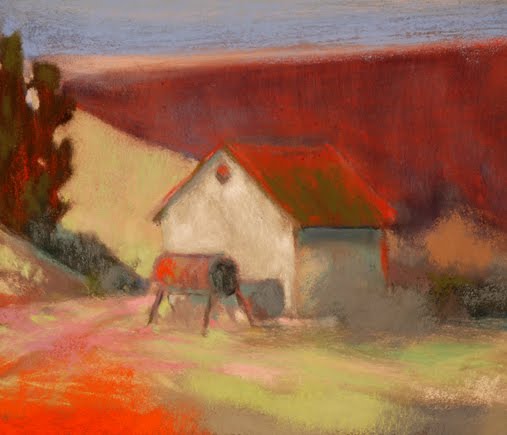![[Waning+Light+72.jpg]](https://blogger.googleusercontent.com/img/b/R29vZ2xl/AVvXsEgVl4J7O1pGniVOJC5fTCz3xTfb_2pIRMiC0aWyKd4q8pNlwRWcmzVCHuU9V1qgbHxWeDRKe_X7mIgCPWQRlgE3T8ErbltnBN8eF_Z7PNp9n7k0FOQzNyIrK590De2tCsjwR5-LbjGfKyk/s1600/Waning+Light+72.jpg)
![[somtimesweather+72.jpg]](https://blogger.googleusercontent.com/img/b/R29vZ2xl/AVvXsEgf4PkMbGl9wEX5vuLnQqDbMGG0EBChEbOqjfL-oyKfAf45jTirUZOnds6TUOi4CnmqYuOcx51DS9gLMAPF-yjeu4VhtLVBZmN0l0qlV068wH_aAWDfacZbV1DEJFnRDamGVIKSh4qZuLQ/s1600/somtimesweather+72.jpg)

It was interesting to see a great pastel artist list his focus on a narrow range of subjects in a book I read recently. The book is a dated one by Albert Handell: Pastel Painting Workshop. He likes the Southwestern landscape with arroyos and pueblo-style structures. He does trees, rock boulders and waterways. In his figurative work, he likes vignettes and portraits.
Why be narrow in subject matter?
It is good to be aware of what your subject matter is before you go off to the field to paint on site. Why be narrow in subject matter? My own feelings are that you may delve into a subject as deeply as you wish, and may never run out of inspiration. If your goal is to "draw things", then you may wish to pursue every possible subject one after the other. But, if you are wanting to produce paintings with depth and with good technique, then limiting yourself to a handful of subjects will provide you a greater opportunity for depth.
Limiting your subject matter will put you in good company.
Limiting your subject matter will put you in good company. Van Gogh stayed with agricultural landscapes in France that revolved around trees, waterways, fields, buildings and bridges. He did portraits and still lifes, but he stayed with common themes. Degas stayed with interior and theatrical figures, such as orchestras, singers and ballerinas. He did nudes at the bath. He also liked the horse track, and some industrial interiors. Daniel Greene stays with the portrait, but in his figurative work he focuses on painting his wife, artist Wende Caporale, in the New York subway with tile mosaic backgrounds. Of course, he does other works, but his series work is a method of staying focused. Harvey Dinnerstein does self portraits where he is painting bare chested, and Andrew Wyeth stayed on the Helga series for a number of years. His Helga series kept true to his own ouevre of rural interiors and moods.
Limiting my subject matter helps tremendously in finding compositions.
My own oeuvre features trees, forests, rivers and the prairie. Sometimes rural buildings are featured, and rarely do I bring in the sky, horizons or light. It's interesting to think of what I purposefully omit. The horizon is too much landscape - too boilerplate. Light is not much of a part of my environment, especially where I grew up on the Washington coast. The sky is better left alone, unless to add a pushing or pulling event, or to set the color concord.
Some of the content of this post was brought forward from a previous tips post, and updated with new material.
Some of the content of this post was brought forward from a previous tips post, and updated with new material.











2 comments:
thank you, I never thought of subject limitations in quite this way, deeper is better from the sense of understanding the fullness of anything....any tips for deciding where it is that you will "light" and blossom most happily?
Yes, Cindy. I think I'll write it as a post, though, since I want to be almost daily at Pastel for a while.
Many thanks for the question, and for reading here.
Post a Comment